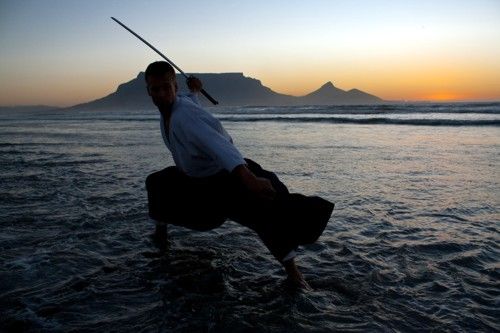Kenjitsu

Kenjitsu is a martial art focussing on the use of the japanese samurai sword (katana). Four disciplines associated with Japanese sword work are:
Kenjitsu kata: Paired attack and defense exercises using the boken (wooden sword) or fukuro shinai (padded bamboo sword).
Batojitsu: Cutting practise. A live blade is used to cut prepared targets made out of wood, bamboo, or grass mats.
Iaijitsu: The practise of drawing the sword, cutting instantly in any direction, and returning the sword to the scabbard. In the beginning stage of learning a boken is used and thereafter an iaito (blunt sword) and finally a live blade.
Free Sparring: For safety, protective clothing and boken or shinai are used.

Traditional schools of kenjitsu such as katori shinto ryu and kashima shinto ryu date back far into the warring states period of japanese history. Samurai (literal meaning "live to serve") were the ferocious and fanatically loyal knights of feudal Japan. They refined their skills in swordsmanship over a period of almost a thousand years of constant war. Skills were compiled into schools (ryu) and usually taught and kept secret within clans. A samurai depended on his sword skill to survive on the battle field, but also saw the pursuit of kenjitsu as a refinement of his character and a matter of honor. A samurai considered his sword to be an extension of his soul and his only true possession. The traditional katana was a weapon of which every part was a work of art, crafted by master artisans. Swords that remain today are considered to be objects of the highest level of art and certain swords dating back to the 12th century contain a level of metallurgy which is unparalleled even in our high tech age today. Swords were passed down through the ages, usually from father to son or within a clan.
The Freedom School approach
Freedom kenjitsu is influenced by elements of kashima shinto ryu, katori shinto ryu, and aiki-ken (aikido sword). Students are taught various basic cuts (suburi), stances (kamai), footwork, eight directional cut (happo-giri), sword drawing (iai-jitsu), contact sparring (sticky sword), flow sparring, and kata that contain essence of the winning cut. Wooden swords (bokken) are used for sparring, partner work, initial cutting and sword drawing, to avoid injury or sword damage. Freedom sword makes use of single or double swords, long or short swords.



